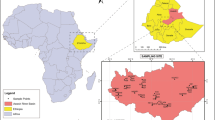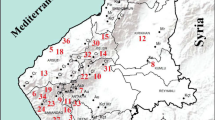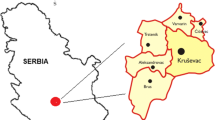Abstract
In this study, the elements of Al, As, B, Ba, Ca, Cd, Co, Cr, Cu, Fe, K, Mg, Mn, Mo, Ni, Sr, Pb, Ti, and Zn were determined in the leaves, fruits, and branches of mistletoe, (Viscum albüm L.), used as a medicinal plant, and in the leaves, branches and barks of almond tree which mistletoe grows on. The aim of the study is to investigate whether the mistletoe are more absorbent than the almond tree in terms of the heavy metal contents and the determination of the amount of the elements penetrated into the mistletoe from the almond tree. ICP-MS (inductively coupled plasma-mass spectrometry) was used for the analysis of As, Cd, Mo, and Pb, whereas ICP-OES (inductively coupled plasma optical emission spectrometry) was used for the other elements. The results obtained were statistically evaluated at 95% confidence level. Within the results obtained in this study, it was determined whether there is a significant difference between metal elements in almond tree and mistletoe, or not. As a result, it was observed that there were higher contents of B, Ba, K, Mg, and Zn in the mistletoe than in the almond tree. K was found much higher than other elements in the mistletoe. On the other hand, Al, As, Ca, Cd, Cr, Cu, Fe, Mo, Ni, Sr, Pb, and Ti contents were determined to be more in almond tree than mistletoe.
Similar content being viewed by others
References
Obbard JB (2001) Ecotoxicological assessment of heavy metals in sewage sludge amended soils. Appl Geochem 16(11-12):1405–1411,58. https://doi.org/10.1016/S0883-2927(01)00042-7
Senesi GS, Baldassarre G, Senesi N, Radina B (1999) Trace element inputs into soils by anthropogenic activities and implications for human health. Chemosphere 39(2):343–337. https://doi.org/10.1016/S0045-6535(99)00115-0
Anonymous. 2002. European Commission DG ENV, E3 Project ENV.E.,3/ETU/2000/0058, “Heavy Metals in Waste” February, Denmark
Gamalero, E., Lingua, G., Berta, G., Glick, B. R., 2009. Beneficial role of plant growth promoting bacteria and arbuscular mycorrhizal fungi on plant responses to heavy metal stress, Canadian Journal of Microbiology, 55(5) 501–514
Arain MB, Kazi TG (2008) Time saving modified BCR sequential extraction procedure for the fraction of Cd, Cr, Cu, Ni, Pb and Zn in sediment samples of polluted lake. J Hazard Mater 160(1):235–239. https://doi.org/10.1016/j.jhazmat.2008.02.092
Yu L, Yan-bin W, Xin G, Yi-bing S, Gang W (2006) Risk assessment of heavy metals in soils and vegetables around non-ferrous metals mining and smelting sites, Baiyin, China. J Environ Sci 18:1124–1134
Goldman P (2001) Herbal medicines today and the roots of modern pharmacology. Ann Intern Med 135(8_Part_1):594–600. https://doi.org/10.7326/0003-4819-135-8_Part_1-200110160-00010
Gomez RM, Cerutti S, Sombra LL, Silva M, Martinez LD (2007) Determination of heavy metals for the quality control in Argentinian herbal medicines by ETAAS and ICP-OES. Food Chem Toxicol 45(6):1060–1064. https://doi.org/10.1016/j.fct.2006.12.013
Ergun, F., Deliorman, D., Şener, B. 1994. Some studies on morphological characters of Viscum albüm L, (Loranthaceae) and its distribution in Turkey, The Herb Journal of Syst Bot, 1 (2): 47–62
Jamison J. R. 2003. Clinical guide to nutrition and dietary supplements in disease management. ISSN: 0443071934,Churchill Livingstone; 1 edition
Miller AG (1982) Loranthaceae. In: Davis PH (ed) Flora of Turkey and the East Aegean Islands, 7th edn. University Press, Edinburgh, pp 546–549
Mandacı, S. 1998. Balıkesir İÜ Tarım ve Orman Alanlarında Ökseotları, Zararları, Koruma ve Savaş Yöntemleri, "Yüksek Lisans Tezi" Uludağ Üniversitesi Fen Bilimleri Enstitüsü, Bursa
Bowen ME, McAlpine CA, House APN, Smith GC (2009) Agricultural landscape modification increases the abundance of an important food resource: mistletoes, birds and brigalow. Biol Conserv 142(1):122–133. https://doi.org/10.1016/j.biocon.2008.10.005
Leea JS, Chona HT, Kimb KW (1998) Migration and dispersion of trace elements in the rock–soil–plant system in areas underlain by black shales and slates of the Okchon Zone, Korea. J Geochem Explor 65(1):61–78. https://doi.org/10.1016/S0375-6742(98)00054-5
García D, Rodríguez‐Cabal MA, Amico GC (2009). Seed dispersal by a frugivorous marsupial shapes the spatial scale of a mistletoe population, Journal of Ecology, 97(2) 217–229
Khwaja TA, Varven JC, Pentecost S, Pande H (1980) Isolation of biologically active Alkoloids from Korean mistletoe Viscum album, coloratum. Experientia 36(5):599–600. https://doi.org/10.1007/BF01965825
Hegi G (1981) Illustrierte Flora von Mitteleuropa III, 309–321. Parey, Berlin
Büssing A, Raak C, Ostermann T (2012) Quality of life and related dimensions in cancer patients treated with mistletoe extract (iscador): a meta-analysis. Evid Based Complement Alternat Med 2012:219402–219408. https://doi.org/10.1155/2012/219402
Eisenbraun J, Scheer R, Kröz M, Schad F, Huber R (2011) Quality of life in breast cancer patients during chemotherapy and concurrent therapy with a mistletoe extract. Phytomedicine 18(2–3):151–157. https://doi.org/10.1016/j.phymed.2010.06.013
Melzer J, Iten F, Hostanska K, Saller R (2009) Efficacy and safety of mistletoe preparations (Viscum album) for patients with cancer diseases. A systematic review. Forsch Komplementmed 16(4):217–226. https://doi.org/10.1159/000226249
Ostermann, T. and Büssing, A., 2012. Retrolective studies on the survival of cancer patients treated with mistletoe extracts: a meta-analysis. Explore (NY), 8(5), 277–281, DOI: https://doi.org/10.1016/j.explore.2012.06.005
Son, G. S., Ryu, W. S., Kim, H. Y., Woo, S. U., Park, K. H. and Bae, J. W. 2010. Immunologic response to mistletoe extract (Viscum album L.) after conventional treatment in patients with operable breast cancer, J. Breast Cancer, 13(1) 14–18, DOI: https://doi.org/10.4048/jbc.2010.13.1.14
Rote L (1994) Editio Cantor. Aulendorflwürtt 1994
Gorter RW, Van Wely M, Reif M (1999) Tolerability of an extract of European mistletoe among immunocompromised and healthy individuals. Altern Ther Health Med 5(6):37–44 47-8
Bar-Sela G, Wollner M, Hammer L, Agbarya A, Dudnik E, Haim N (2013) Mistletoe as complementary treatment in patients with advanced non-small-cell lung cancer treated with carboplatin-based combinations: a randomised phase II study. Eur J Cancer 49(5):1058–1064. https://doi.org/10.1016/j.ejca.2012.11.007
Gunver SK, Helmut K (2010) Review article: influence of Viscum album L (European mistletoe) extracts on quality of life in cancer patients: a systematic review of controlled clinical studies. Integ Cancer Ther 9(2):142–157
Marvibaigi, M., Supriyanto,E.,Amini, N., Majid, F. A. A. and Jaganathan, S.K., 2014. Preclinical and clinical effects of mistletoe against breast cancer, BioMed Research International,:785479, 15 pages, doi:https://doi.org/10.1155/2014/785479
Temür N (2006) Çam, kavak, söğüt ve armut ağaçları üzerinde yetişen ökse otu (Viscum album L,) bitkilerinin antioksidan aktivitelerinin incelenmesi. Gaziosmanpaşa Üniversitesi, Fen Bilimleri Enstitüsü, Yüksek Lisans Tezi, Tokat
Jurin M, Zarkovic N, Hrzenjak M, Blic Z (1993) Antitumorous and immunomodulatory effects of the Viscum album L, preparation Isorel. Oncology 50(6):393–398. https://doi.org/10.1159/000227217
Bar-Sela G, Gershony A, Haim N (2006) Mistletoe (Viscum album) preparations: an optional drug for cancer patients? Harefuah 145(1):42–46 77. Review. Hebrew
Semiglazov VF, Stepula VV, Dudov A, Schnitker J, Mengs U (2006) Quality of life is improved in breast cancer patients by Standardised Mistletoe Extract PS76A2 during chemotherapy and follow-up: a randomised, placebo-controlled, double-blind, multicentre clinical trial. Anticancer Res 26(2 B):1519–1529
Vester F, El-Fouly Bohnel M (1968) Zurkenntris der inhalt Staffe von Viscum album, IV Biologisches verhalten einzelner protein fraktionen, Hoppe-SeylerÕs, Z. Physiol Chem 349(1):495–511. https://doi.org/10.1515/bchm2.1968.349.1.495
Gray AM, Flatt PR (1999) Insulin-secreting activity of the traditional antidiabetic plant Viscum album (mistletoe). J Endocrinol 160(3):409–414. https://doi.org/10.1677/joe.0.1600409
Büssing A, Schietzel M (1999) Apoptosis-inducing properties of Viscum album L. extracts from different host trees, correlate with their content of toxic mistletoe lectins. Anticancer Res 19(1A):23–28
Önay-Uçar E, Karagöz A, Arda N (2006) Antioxidant activity of viscum album ssp. album. Fitoterapia 77(7-8):556–560. https://doi.org/10.1016/j.fitote.2006.08.001
Hamprecht K, Handgretinger R, Voetsch W, Anderer FA (1987) Mediation of human NK-activity by components in extracts of viscum album. Int J Immunopharmacol 9(2):199–209. https://doi.org/10.1016/0192-0561(87)90095-6
Kovacs E, Hajto T, Hostanska K (1991) Improvement of DNA repair in lymphocytes of breast cancer patients treated with Viscum album extract (Iscador). Eur J Cancer 27(12):1672–1676
Çelebioğlu, H. U. 2012. Effect of medicinal plants epilobium hirsutum and viscum album on rat liver microsomal flavin monooxygenase (fmo) activity and expression. Msc Thesisin Biology, Graduate School of Natural and Applied Sciences of Middle East Technical University
Knöpfl-Sidler F, Viviani A, Rist L, Hensel A (2005) Human cancer cells exhibit in vitro individual receptiveness towards different mistletoe extracts. Pharmazie. Jun 60(6):448–454
Kienle GS, Glockmann A, Schink M, Kiene H (2009) Viscum album L. extracts in breast and gynaecological cancers: a systematic review of clinical and preclinical research. J Exp Clin Cancer Res 28:79. https://doi.org/10.1186/1756-9966-28-79
Kienle GS, Grugel R, Kiene H (2011) Safety of higher dosages of Viscum album L in animals and humans—systematic review of immune changes and safety parameters. BMC Complement Altern Med 11(1):72
Matthes H, Friedel WE, Bock PR, Zänker KS (2010) Molecular mistletoe therapy: friend or foe in established anti-tumor protocols? A multicenter, controlled, retrospective pharmacoepidemiological study in pancreas cancer. Curr Mol Med 10(4):430–439. https://doi.org/10.2174/156652410791317057
Grossarth-Maticek R, Ziegler R (2007) Prospective controlled cohort studies on long-term therapy of ovairian cancer patients with mistletoe (Viscum album L.) extracts iscador. Arzneimittelforschung 57(10):665–678. https://doi.org/10.1055/s-0031-1296666
Kunze E, Schulz H, Ahrens H, Gabıus H-J (1997) Lack of an antitumotral effect of immunmodulatory galactoside-spesific mistletoe lectin on N-methyl-N-nitrosourea-induced urinary bladder carcinogenesis in rats. Toxic Pathol 49(3-4):167–180. https://doi.org/10.1016/S0940-2993(97)80004-8
Molassiotis A, Scott JA, Kearney N, Pud D, Magri M, Selvekerova S, Bruyns I, Fernadez-Ortega P, Panteli V, Margulies A, Gudmundsdottir G, Milovics L, Ozden G, Platin N, Patiraki E (2006) Complementary and Alternative Medicine use in Breast Cancer Patients in Europe. Support Care Cancer 14(3):260–267
Skoog D, Holler FJ, Nieman TA (1998) Principles of Instrumental, Çeviri Editörleri, Kılıç E, Köseoglu F, Yılmaz H. Bilim Yayıncılık, Ankara, 230-251
D’angelo JA, Martinez LD, Resnizky S, Perino E, Marchewsky EJ (2001) Determination of eight lanthanides in apatites by ICP-AES, XRF and NAA. J, Trace Microprobe Techn 19:79–90
Lara, R.F, Wuilloud, R.G., Salonia, J.A., Olsina, R.A, ve Martinez, L.D. 2001. Determination of low cadmium concentrations in wine by on line preconcentration in a knotted reactor coupled to an inductively coupled plasma optical emission spectrometer with ultrasonic nebulization, Fresenius J,Analytical Chem., 371: 989–993
Montgomery DC (2004) Design and analysis of experiments, 6th edn. John Wiley & Sons Inc, NJ ISBN-10: 047148735X
Başgel S, Erdemoğlu SB (2006) Determination of mineral and trace elements in some medicinal herbs and their demlemes consumed in Turkey. Science of theTotal Environment 359(1-3):82–89. https://doi.org/10.1016/j.scitotenv.2005.04.016
Malik, J., Frankova, A., Drabek, O., Szakova, J., Ash, C., Kokoska, L.2013. Aluminium and other elements in selected herbal tea plant species and their infusions Czech Republic
Parthik P., Patel N.M., Patel P.M. 2011. WHO guidelines on quality control of herbal medicines, IJRAP, 2 (4) 1148–1154 Department of quality assurance BMCPER Modasa, India
Tokalıoğlu, Ş. 2012. Determination of trace elements in commonly consumed medicinal herbs by ICP-MS and multivariate analysis, Food Chem 2012;134(4):2504–2508. doi:https://doi.org/10.1016/j.foodchem.2012.04.093
Kabata-Pendias A, Mukherjee AB (2007) Trace element for soil to human, ISBN:3540327134. Springer, New York. https://doi.org/10.1007/978-3-540-32714-1
Deveci T 2012Determination of trace elements (Cu, Co, Mn and Zn) and iron concentrations in soil and vegetables irrigated with domestic and industrial wastewaters of Gaziantep City, MSc. Thesis, Kilis 7 Aralık University Graduate School of Natural and Applied Sciences Department of Chemistry, TURKEY
Belitz HD, Grosch W, Schieberle P (2009) Food Chemıstry, 3rd edn. Springer, Berlin
Jabeen, S., Shah, M.T., Khan, S., Hayat M.K. 2010. Determination of major and trace elements in ten important folk therapeutic plants of Haripur basin, Pakistan
Blicharska, E., Komsta, L., Kocjan, R., Gumieniczek, A., Robak, A. 2010. A preliminary study on the effect of mineralization parameters on determination of metals in Viscum Album species 20–081 Lublin-Poland
Garg AN, Kumar AGC, Reddy AVR (2007) Analysis of come Indian medicinal herbs by INAA. J Radioanal Nucl Chem 271(3):611–619. https://doi.org/10.1007/s10967-007-0316-9
Fei, T., Dehong, L., Fengqun, Z., Junhua, L., Hua,T., Xiangzhong, K. 2010. Determination of trace elements in Chinesse medicinal plants by instrumental neutron activation analysıs. J Radioanal Nucl Chem, 284, 507–511, 3, DOI: https://doi.org/10.1007/s10967-010-0503-y
Street, R.A., Kulkarni, M.G., Stirk, W.A., Southway, C., Staden, J.V. 2008. Variation in heavy metals and microelements in South African medicinal plants obtained from street markets. Research Centre for plant growth and development, school of biological and conservation sciences, School of Chemistry University of Kwazulu-Natal pietemaritzburg, Scottsville 3201, South Africa, 25, 8, 953, 960, DOI: https://doi.org/10.1080/02652030801993605
Xie JH, Shen MY, Xie MY, Nie SP, Chen Y, Li C, Huang DF, Wang YX (2012) Ultrasonicassisted extraction, antimicrobial and antioxidant activity of Cyclocarya paliurus (Batal.) Iljinskaja polysaccharides. Carbohydr Polym 89(1):177–184. https://doi.org/10.1016/j.carbpol.2012.02.068
Walter, M., 2012. Trace elements in human and animal nutrition, Burlington Elsevier Science Volume 2
Chen T, Liu X, Zhu M, Zhao K, Wu J, Xu J, Huang P (2008) Identification of trace element sources and associated risk assessment in vegetable soils of the urban–rural transitional area of Hangzhou, China. Environ Pollut 151(1):67–78. https://doi.org/10.1016/j.envpol.2007.03.004
Hamid, A., Riaz, H., Akhtar, S. and Ahmad, S. R 2016. Heavy metal contamination in vegetables, soil and water and potential health risk assessment, Am Eurasian J Agric and Environ Sci, 16 (4): 786–794
March WA, Watson DM (2010) The contribution of mistletoes to nutrient returns: evidence for a critical role in nutrient cycling. Ecol Soc Aust 35(7):713–721
Vidal-Russell R, Nickrent DL (2008) The first mistletoes: origins of aerial parasitism in Santalales. Mol Phylogenet Evol 47(2):523–537. https://doi.org/10.1016/j.ympev.2008.01.016
Bannister P, Strong GL (2001) Carbon and nitrogen isotope ratios, nitrogen content and heterotrophy in New Zealand mistletoes. Oecologia 126(1):10–20. https://doi.org/10.1007/s004420000495
Matsubara S, Morosinotto T, Bassi R, Christian AL, Fischer-Schliebs E, Lüttge U, Orthen B, Franco AC, Scarano FR, Förster B, Pogson BJ, Osmond CB (2003) Occurrence of the lutein-epoxide cycle in mistletoes of the Loranthaceae and Viscaceae. Planta 217(6):868–879. https://doi.org/10.1007/s00425-003-1059-7
Author information
Authors and Affiliations
Corresponding author
Ethics declarations
Conflict of Interest
The authors declare that they have no conflict of interest.
Rights and permissions
About this article
Cite this article
Kamar, V., Dağalp, R. & Taştekin, M. Determination of Heavy Metals in Almonds and Mistletoe as a Parasite Growing on the Almond Tree Using ICP-OES or ICP-MS. Biol Trace Elem Res 185, 226–235 (2018). https://doi.org/10.1007/s12011-017-1223-8
Received:
Accepted:
Published:
Issue Date:
DOI: https://doi.org/10.1007/s12011-017-1223-8




